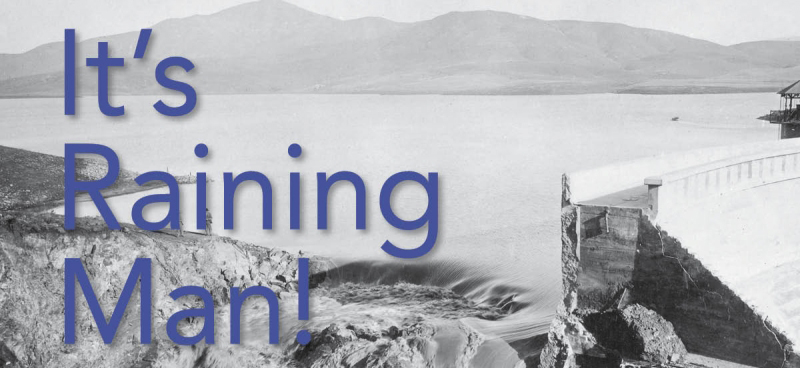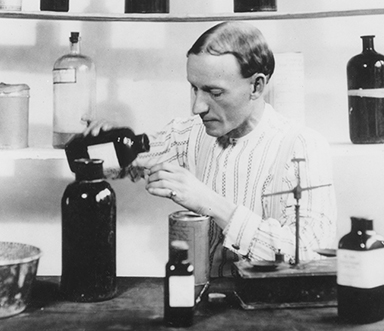Exhibitions

It’s Raining Man!
San Diego’s Cataclysmic 1916 Hatfield Flood
January 22, 2016 – March 13, 2016

JANUARY 1916! A WET MONTH FOR THE HISTORY BOOKS
One hundred years ago, San Diego withstood one of the most torrential downpours on record, the 1916 Hatfield Flood. The flood was so severe it caused widespread devastation to the growing region, fresh out of the success of the 1915 Panama-California Exposition. Locally, the heavy rain and subsequent flood was attributed to Mr. Charles Mallory Hatfield, a cattle rancher turned sewing machine salesman, who found an affinity for weather systems and sought a better understanding of meteorology. Hatfield referred to himself as a Moisture Accelerator, and hired a promoter to get word out about his skills. Due to additional rainmaking successes in areas outside of San Diego County, he became known as a Rainmaker, a position he would find himself fleeing in what became one of the most notable weather disasters in the region’s history.
Unusual weather conditions existed in the San Diego region in the years preceding 1916. Cattle ranchers, citrus industry farmers, and agricultural investors marked repeatedly that something needed to be done or else the economy would be threatened. Meanwhile Hatfield used the time to perfect his rain inducing methods.
Ultimately the right combination of 23 chemicals* was found and demonstrated repeatedly to prove Hatfield’s ability to carry out his claims to produce a certain number of inches of rainwater fulfilling numerous contracts in exchange for significant cash payments. Hatfield originally approached city officials with his plan to fill the region’s reservoirs as early as 1912 but was turned away.
His later successes elsewhere coupled with the sight of empty dams like the Sweetwater Dam provided Councilors evidence to reconsider his offer. They would meet in December 1915 for another demonstration by Hatfield and to discuss terms of a potential contract for filling Morena reservoir. Based off the reaction of the city officials to the recent rainfall, Hatfield took the majority vote to mean that he had convinced the city this time. He left the meeting for Morena, with his brother Paul, to set up his towers, feeling confident he had an agreed-upon contract.
The Contract:
“Could you fill Morena Reservoir?” A Councilman asked.
Without hesitation Hatfield answered, “YES!”
In December 2015, the City Council, although divided in their decision, hired Hatfield to fill the Morena Reservoir, some 60 miles East of San Diego, just north of the town of Campo with 10 billion additional gallons of fresh water. Combined with the approximate 5 billion gallons already held in the reservoir would give the city a substantial boost to its severely limited water supply. His success there would help the city determine ownership rights of the region’s water supply in the future.
Hatfield’s agreement with the City, though never officially signed, would pay Hatfield $10,000 to fill the reservoir to overflowing. His work was to begin on January 1, 1916, and had the entire 1916 year to do so. Hatfield, in turn, promised not to charge the City a cent if he were unable to meet his agreements.
Hatfield’s Rain Accelerator System:
His system for making rain was simple. He, with the aid of his brother Paul, erected four 12-foot towers about 50 feet apart and places on top of each a shallow galvanized tray four inches deep and four feet square. He fills them with a chemical solution. “Time and the atmosphere absorb the liquid solution and down comes the rains,” Hatfield said. The recipe for the chemical solution has never been revealed. When Charles died in January 1958 he took the recipe for the chemical mixture with him. “He didn’t ever tell” Paul the surviving brother told newspapers at the time of Charles death and Paul has subsequently taken the recipe to the grave with his death.
24 Days of Rain!:
On January 5, 1916, Charles Hatfield, and City Councilors alike, sighed relief as rain began to fall. Unbeknownst to all involved was that he would unleash a fury of storms that would soon overwhelm the dams, streams, and reservoirs of the region. Twenty four days of torrential downpours left a submerged and stranded city as railroads, roadways, bridges, and trestles were no match for the undaunting deluge.
People claimed that the first wave of rainstorms was enough for Hatfield to petition the city commission and his work at Morena was finished. Coming down out of the hills the rain began to subside. He stepped up to the council only to be rejected his payment. At which point he and his brother returned to their encampment and began operations again. The results would be the overflow and destruction of the earthen embankment attaching the Sweetwater Dam to the adjacent hillside which sent a wall of water through the Sweetwater valley stripping the surrounding landscape to the very bedrock below.
The worst of the catastrophes happened in the Tijuana River Valley where it was reported that the Lower Otay Dam simply popped, pushing out from the center all at once, sending a wall of water 40 feet high at times careening through the valley hurdling debris, animals, people and remains of buildings including the small utopian community The Little Landers who were located in the San Ysidro Valley. The Lower Otay dam burst at 6pm when many were sitting down to their evening meals. Folks speak of seeing the black mist traveling quickly ahead of the wall of water but the people in The Little Lander community got word of their fate too late for everyone to escape to safety. In all 20 persons lost their lives to this watery grave.
The Benson Brothers: With the breaking of the region’s dams, Charles and Paul Hatfield realized the impact of their rainmaking endeavors and tried to flee the area. In chance that local farmers were looking for them specifically they introduced themselves as the Benson Brothers and refused any connection to the flooding in the area.
A Slow Recovery:
San Diego was virtually cut off from mainland transportation as the flooding cut rail lines bridges and road beds all across the County. For 32 days all goods and services bound for San Diego City had to be transported by boat. All told 112 bridges streets and railroad trestles and streetcar lines were wiped clean of their moorings. In the San Diego River entire trains were lost as they were placed on bridges in an effort to anchor the bridges from floating away. The Santa Fe Railway lost considerable fares in the ensuing days having lost their rail lines in more than one location. The trains were stranded in many instance including the submerged train station along Broadway in downtown San Diego.
The lack of transportation made attendance at the 1916 Panama-California International Exposition sluggish to start causing organizers to wrench hands wondering how long it would take to bring the crowds back to the city. It would take the Santa Fe Railway nearly 2 months to rebuild all that was necessary to make safe travel available to San Diego from the north once again.
Hatfield was determined that his activity produced the water to fill the dame at Morena. However he was not responsible for all the regional destruction amounting to approximately $3.5 million dollars including the loss of the Little Lander community. Those happenings were an Act of God. Confident that he could persuade the city leaders that he kept his end of the bargain he approached them for his $10000 payment in February 1916. The city in turn slapped him with a rising bill of damages ($3.5 million) that he would be responsible for covering if the city paid his fee. Hatfield refused to do so. Hoping to resolve matters he attempted to lower the fee to $4000 but when that amount was refused by city leaders as well. Hatfield entrenched himself at court as he determined to countersue the city.
Twenty two years later the issue would come to a resounding end as a local court judge ordered in his favor. Not hindered by the damage or loss of life associated with the flood, Hatfield turned the calamity to his advantage and went on to become one of the most famous of the era’s rainmakers.
Charles Hatfield died in January 1958 taking with him the recipe of 23 chemicals* that brought about the 1916 San Diego Flood. But his memory lives on in many forms. His story has been made into a stage play and the 1956 Hollywood film The Rainmaker starring Burt Lancaster as a Hatfield-like character along with the historic documentation and photographs that vividly bring his story to life making it as fresh today as it was a century ago.












